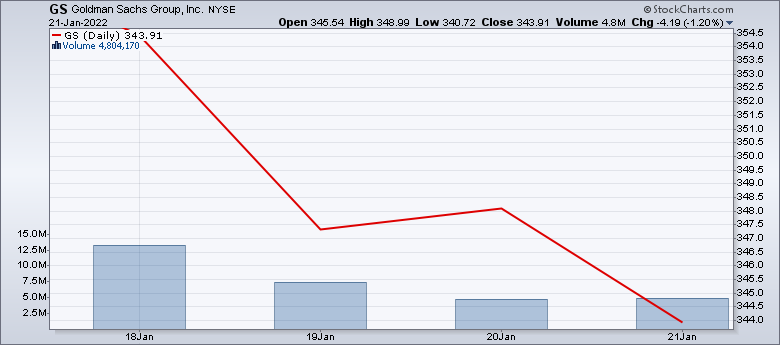Just a jaw-dropping Q4 2021 earnings report from Goldman Sachs (NYSE: GS) this past Tuesday. I sense for many of us, 2021 felt like a ‘Go-Go’ year for investment banking, mergers and acquisitions, new equity and debt issuance, and SPAC activity. But to see that ‘feeling’ instantiated in Goldman’s Full Year and Fourth Quarter 2021 Earnings report, quantified in blow-out numbers across almost all performance metrics, was really something to behold. The Financial Times’ characterized the 30,000-foot perspective well, “Despite earnings missing estimates in the fourth quarter, full-year net profit for 2021 came in at $21.2bn, more than double the level in 2020, and easily the largest in the bank’s history.” (emphasis added)
Digging in to the 2021 numbers, here’s the high-level for the whole company:
- Net revenues for entire year -> $59.34 Billion *record*
- Net earnings for entire year -> $21.64 Billion *record*
- Diluted EPS for entire year -> $59.45 *record*
and here’s the high-level for Goldman’s separate investment banking business lines:
- Aggregate net revenues for entire year -> $14.88 Billion *record*. Teased out, this includes record net revenues from financial advisory services, equity underwritings, and debt underwritings.
- #1 ranking in the world for announced and completed mergers and acquisitions for equity related offerings, common stock offerings, and initial public offerings (data source Dealogic )
If you owned Goldman going into this release, you’ve got to be pleased with its performance. And if you didn’t, there’s an argument to be made that despite current market volatility and the post-release pullback due to its miss on Q4 earnings estimates, its current share price is worthy of consideration for an entry point.
 Goldman (NYSE: GS) Stock Price – week ending 1.21.2022
Goldman (NYSE: GS) Stock Price – week ending 1.21.2022
But I digress.
The 2021 quarterly comparison – Q3 to Q4 – also reinforced the whole-year trend in investment banking with 3% growth, and net revenue totaling $3.80 billion across all investment banking segments.
So why is this important, other than the historic level of investment banking activity?
It ties-back to a blog I wrote last week suggesting that the extraordinary amount of venture capital raised, and corporate debt floated, in the first week of 2022 indicates that the imminence of a higher interest rate regime is very much on the mind of investors, and strategics seeking growth through M&A. More simply stated, there’s a mad rush to procure cheap capital.
I also suggested that for meaningful clues as to how the rest of 2022 would play-out for raising capital and M&A activity, I’d be closely monitoring the bulge-bracket investment banks’ spring earnings releases, especially those of Goldman Sachs and Morgan Stanley.
Thus, the importance of this week’s numbers from Goldman serve to confirm what by all accounts will be looked back upon as investment banking’s ‘go-go’ year of 2021. What most of us intuited to be true regarding the proliferation of equities, and debt securities in 2021, has been validated. And by extension, Goldman’s Q4 numbers now serve as a high-value reference point to which one can compare those really important spring numbers to. A high-value reference point because if there’s going to be a break in the momentum of the historically high level of investment banking activity in 2021, we now know that recent events, particularly indications from the Fed on the intensity and speed of tightening, didn’t show-up in the bulge-bracket’s Q4 performance.
Investment bank take…
It wasn’t until mid-December that the “Powell Pivot” entered the psyche of the market. It was at this time that the Fed first ditched the word “transitory” in describing the rising inflationary environment. Likewise, it wasn’t until mid-December’s meeting that the Fed floated the idea of accelerating its tightening, pushing up their previously proposed schedule of 2022 rate hikes.
What we see from Goldman’s Q4 release is that its quarter was ‘clean’ – there wasn’t sufficient time for the Powell Pivot to materially affect investment banking activity in the October – December period.
Thus, the clean Q4 serves as a meaningful starting point from which to compare Goldman’s spring release of Q1’s performance – a quarter which I anticipate will show a slowdown in investment banking activity, especially when synthesized with the (apparent) rush to secure cheap capital in the first week of the year.
And as I also alluded to in last week’s blog – M&A Crosscurrents 2022 – , an interest rate hike induced rush to secure cheaper capital combined with a slowdown in investment and M&A activity will flow through to asset valuations, likely applying a negative pressure.
But truth be told, we just won’t know for sure for another three months when we see the data.
Hopefully.
That’s because the high level of current market volatility (largely interest rate induced) also needs to be accounted for in what is likely to be a slowdown in new debt and equity issuance, creating additional complexity in deriving meaningful insights from the next quarter of earnings.